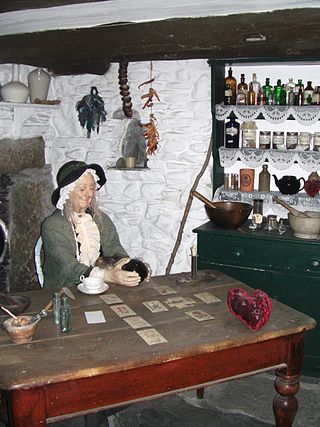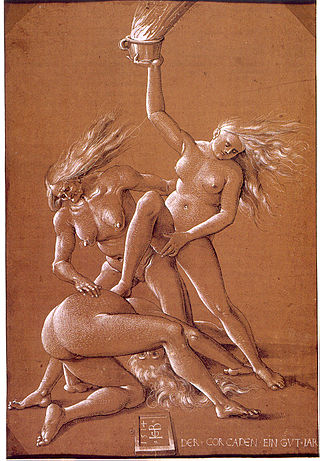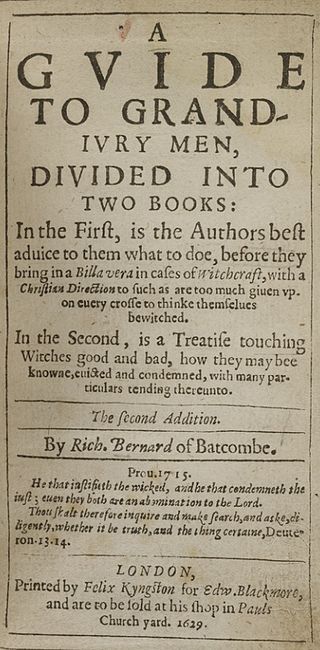Witchcraft, as most commonly understood in both historical and present-day communities, is the use of alleged supernatural powers of magic. A witch is a practitioner of witchcraft. Traditionally, "witchcraft" means the use of magic or supernatural powers to inflict harm or misfortune on others, and this remains the most common and widespread meaning. According to Encyclopedia Britannica, "Witchcraft thus defined exists more in the imagination of contemporaries than in any objective reality. Yet this stereotype has a long history and has constituted for many cultures a viable explanation of evil in the world". The belief in witchcraft has been found in a great number of societies worldwide. Anthropologists have applied the English term "witchcraft" to similar beliefs in occult practices in many different cultures, and societies that have adopted the English language have often internalised the term.

Matthew Hopkins was an English witch-hunter whose career flourished during the English Civil War. He was mainly active in East Anglia and claimed to hold the office of Witchfinder General, although that title was never bestowed by Parliament.

In European folklore of the medieval and early modern periods, familiars were believed to be supernatural entities or spiritual guardians that would protect or assist witches and cunning folk in their practice of magic. According to records of the time, those alleging to have had contact with familiar spirits reported that they could manifest as numerous forms, usually as an animal, but sometimes as a human or humanoid figure, and were described as "clearly defined, three-dimensional... forms, vivid with colour and animated with movement and sound", as opposed to descriptions of ghosts with their "smoky, undefined form[s]".

The cunning folk were professional or semi-professional practitioners of magic in Europe from the medieval period through the early 20th century. In Britain they were known by a variety of names in different regions of the country, including wise men and wise women, pellars, wizards, dyn hysbys, and sometimes white witches.

European witchcraft is a multifaceted historical and cultural phenomenon that unfolded over centuries, leaving a mark on the continent's social, religious, and legal landscapes. The roots of European witchcraft trace back to classical antiquity when concepts of magic and religion were closely related, and society closely integrated magic and supernatural beliefs. Ancient Rome, then a pagan society, had laws against harmful magic. In the Middle Ages, accusations of heresy and devil worship grew more prevalent. By the early modern period, major witch hunts began to take place, partly fueled by religious tensions, societal anxieties, and economic upheaval. Witches were often viewed as dangerous sorceresses or sorcerers in a pact with the Devil, capable of causing harm through black magic. A feminist interpretation of the witch trials is that misogynist views of women led to the association of women and malevolent witchcraft.

The Witches of Belvoir were a mother and her two daughters accused of witchcraft in England and the deaths of two young brothers, Henry and Francis Manners, the heirs to Francis Manners, 6th Earl of Rutland, whose seat was at Belvoir Castle. The mother, Joan Flower, died on the way to her trial after apprehension 'around Christmas' of 1618, while Philippa and Margaret were executed by hanging on 11 March 1619.

Witch, from the Old English wiċċe, is a term rooted in European folklore and superstition for a practitioner of witchcraft, magic or sorcery. Traditionally associated with malevolent magic, with those accused of witchcraft being the target of witch-hunts, in the modern era the term has taken on different meanings. In literature, a 'witch' can now simply refer to an alluring women capable of 'bewitching' others. In neopagan religions such as Wicca the term has meanwhile been adopted as the female term for an adherent.
The Witches of Warboys were Alice Samuel and her family, who were accused of, and executed for witchcraft between 1589 and 1593 in the village of Warboys, in the Fens of England. It was one of many witch trials in the early modern period, but scholar Barbara Rosen claims it "attracted probably more notice than any other in the sixteenth century".

The Museum of Witchcraft and Magic, formerly known as the Museum of Witchcraft, is a museum dedicated to European witchcraft and magic located in the village of Boscastle in Cornwall, south-west England. It houses exhibits devoted to folk magic, ceremonial magic, Freemasonry, and Wicca, with its collection of such objects having been described as the largest in the world.

The Bury St Edmunds witch trials were a series of trials conducted intermittently between the years 1599 and 1694 in the town of Bury St Edmunds in Suffolk, England.
Ursula Kemp or Ursley Kempe alias Grey was an English cunning woman and midwife who in 1582 was tried for witchcraft and hanged. Kemp was accused of using familiars to kill and bring sickness to her neighbour.

The trials of the Pendle witches in 1612 are among the most famous witch trials in English history, and some of the best recorded of the 17th century. The twelve accused lived in the area surrounding Pendle Hill in Lancashire, and were charged with the murders of ten people by the use of witchcraft. All but two were tried at Lancaster Assizes on 18–19 August 1612, along with the Samlesbury witches and others, in a series of trials that have become known as the Lancashire witch trials. One was tried at York Assizes on 27 July 1612, and another died in prison. Of the eleven who went to trial – nine women and two men – ten were found guilty and executed by hanging; one was found not guilty.
John Darrell was an Anglican clergyman noted for his Puritan views and his practice as an exorcist, which led to imprisonment.

Cunning folk, also known as folk healers or wise folk, were practitioners of folk medicine, helpful folk magic and divination in Europe from the Middle Ages until the 20th century. Their practices were known as the cunning craft. Their services also included thwarting witchcraft. Although some cunning folk were denounced as witches themselves, they made up a minority of those accused, and the common people generally made a distinction between the two. The name 'cunning folk' originally referred to folk-healers and magic-workers in Britain, but the name is now applied as an umbrella term for similar people in other parts of Europe.

Jeanne des Anges, also known as Jeanne de Belcier, was a French Ursuline nun in Loudun, France. She became mother superior of the convent at a young age, but is chiefly remembered as a central figure in the case of the possessed of Loudun in 1632, which led, after witch trials, to the burning at the stake of the priest Urbain Grandier two years later.

A Guide to Grand-Jury Men — in full, A Guide to Grand Jury Men, Divided in two books. In the first, is the Author's best advice to them what to do, before they bring in a Billa vera in cases of Witchcraft, with a Christian Direction to such as are too much given upon every cross to think themselves bewitched. In the Second, is a Treatise touching Witches good and bad, how they may be known, evicted, condemned, with many particulars tending thereunto was first published in 1627 and written by a puritan clergyman named Richard Bernard.
James "Jim" A. Sharpe, FRHS, is professor emeritus of early modern history at the University of York. He is a specialist in witchcraft, and crime and punishment, in early modern England.
Anne Gunter was an English woman who was thought to be possessed by a demon after she reputedly brought forth pins from several orifices. The accusations attracted the brief attention of James I of England. The case was championed by her father, Brian Gunter, who had previously killed two sons of the Gregory family during a game of football. Gunter accused three women, including Elizabeth Gregory, of witchcraft against his daughter Anne. The case was settled by the Star Chamber who found that her purported possession was her father's invention. It is claimed that Anne's misadventure is the best documented English witchcraft case.

Elleine Smith was an English woman executed for witchcraft, and known from one of four surviving pamphlets detailing the so-called Essex Witches. The others mentioned were Elizabeth Frauncis, Margery Staunton and Alice Nokes.
Anne Kerke or Anne Kirk, was an English woman executed for witchcraft.












